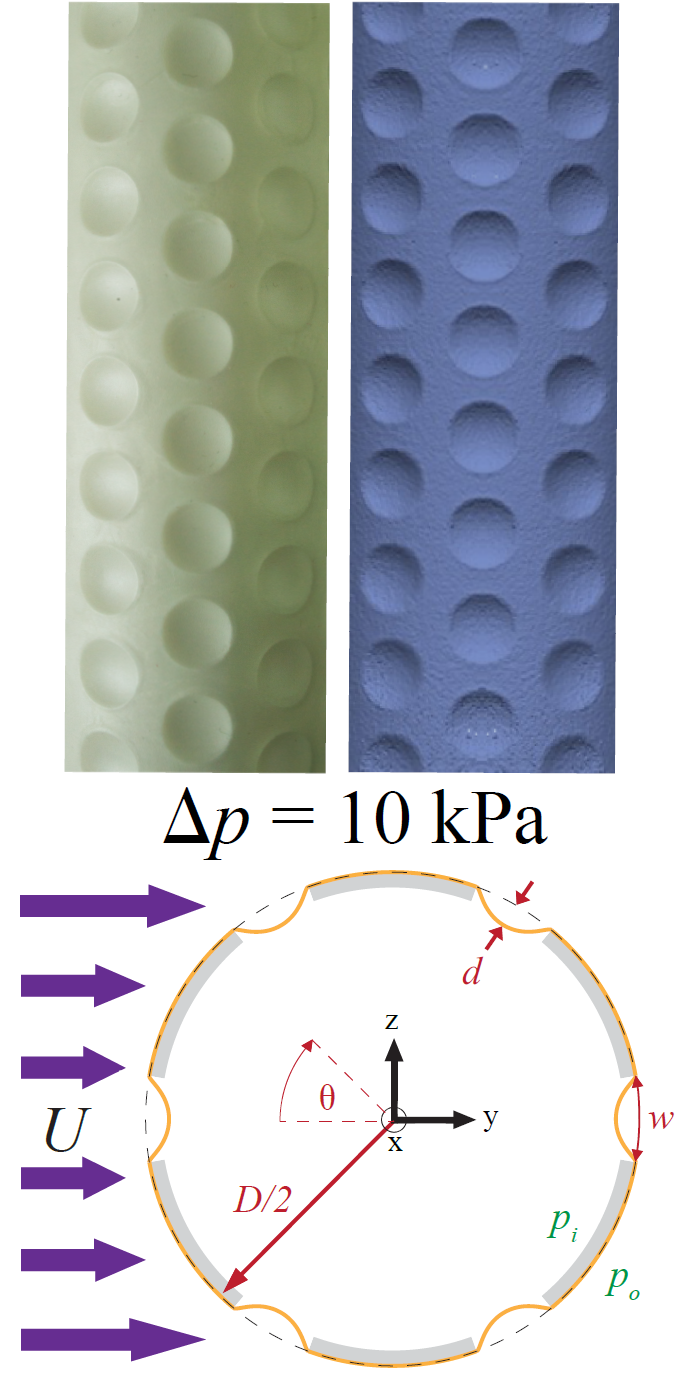Fluid-structure interactions (FSI) are ubiquitous in nature and engineering. They occur at all scales from the swimming of microorganisms, elastocapillary collapse of MEMS or carbon nanotube forests, to the dynamical stability of offshore structures, and the catastrophic failure of solar drones. Complex nonlinear problems often arise when the deformation of a structure couples with the mechanics of a fluid through its surface tension, inertia, viscosity or other rheological properties. This diversity of FSI problems calls for a plethora of approaches and methodologies, including: reduced analytical models, scaling analyses, multiphysics numerical methods, and laboratory experiments. In particular, we focus on fluid-structure interactions where the aerodynamic or the hydrodynamic loading can induce large deformations of a flexible slender structures. We also sometimes apply our experimental methodology to study broader problems in fluid mechanics.
Topics that we have investigated in the area of fluid dynamics and fluid-structure interactions include: on-demand drag reduction of structures with morphable tography, grabbing water with a flexible structures, rapid fabrication of slender elastic shells by viscous coating, and buckling of bacterial flagella. A more detailed account of these examples and other problems is provided below.
Fluid-structure interactions of bristled wings: The trade-off between weight and drag
with: Y. L. Lin, and M. Pezzulla
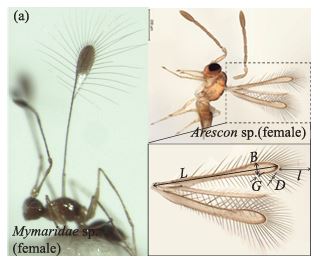
The smallest flying insects often have bristled wings resembling feathers or combs. We combined experiments and three-dimensional numerical simulations to investigate the tradeoff between wing weight and drag generation. In experiments of bristled strips, a reduced physical model of the bristled wing, we found that the elasto-viscous number indicates when reconfiguration occurs in the bristles. Analysis of existing biological data suggested that bristled wings of miniature insects lie below the reconfiguration threshold, thus avoiding drag reduction. Numerical simulations of bristled strips showed that there exist optimal numbers of bristles that maximize the weighted drag when the additional volume due to the bristles is taken into account. We found a scaling relationship between the rescaled optimal numbers and the dimensionless bristle length. This result agrees qualitatively with and provides an upper bound for the bristled wing morphological data analyzed in this study.
Publications:
• Y. L. Lin, M. Pezzulla, and P. M. Reis, “Fluid-structure interactions of bristled wings: The trade-off between weight and drag”, Journal of the Royal Society Interface, 20, 20230266, (2023). [html, pdf]
Spontaneous formation of a self-healing carbon nanoskin at the liquid-liquid interface
with: E. Bomal, P. Grandgeorge, R. Yeo, N. Candau, and H. Frauenrath
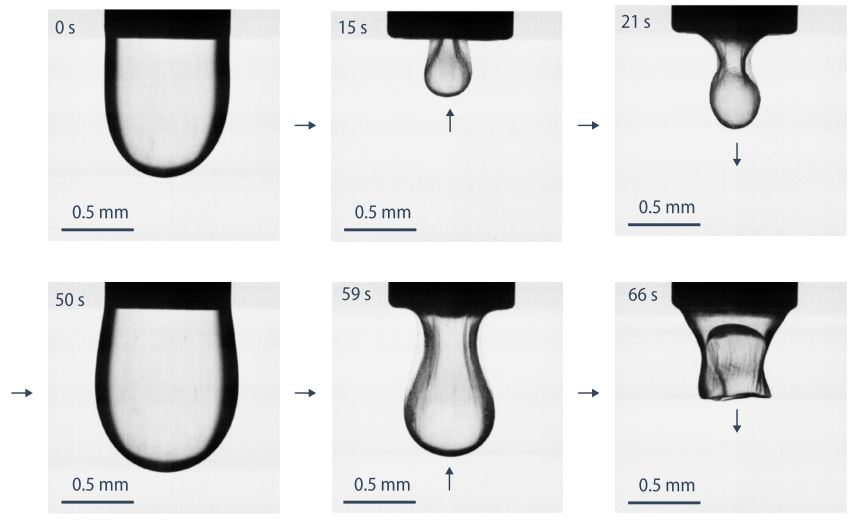
Biological membranes exhibit the ability to self-repair and dynamically change their shape while remaining impermeable. Yet, these defining features are difficult to reconcile with mechanical robustness. Here, we report on the spontaneous formation of a carbon nanoskin at the oil–water interface that uniquely combines self-healing attributes with high stiffness. Upon the diffusion-controlled self-assembly of a reactive molecular surfactant at the interface, a solid elastic membrane forms within seconds and evolves into a continuous carbon monolayer with a thickness of a few nanometers. This nanoskin has a stiffness typical for a 2D carbon material with an elastic modulus in bending of more than 40–100 GPa; while brittle, it shows the ability to self-heal upon rupture, can be reversibly reshaped, and sustains complex shapes. We anticipate such an unusual 2D carbon nanomaterial to inspire novel approaches towards the formation of synthetic cells with rigid shells, additive manufacturing of composites, and compartmentalization in industrial catalysis.
Publications:
• E. Bomal, P. Grandgeorge, R. Yeo, N. Candau, P. M. Reis, and H. Frauenrath, “Spontaneous formation of a self-healing carbon nanoskin at the liquid-liquid interface”, Nature Communications, 13, 4950 (2022). [html, pdf]
Not gone with the wind: Active microscale flight with highly porous bristled wings
with: Y. L. Lin
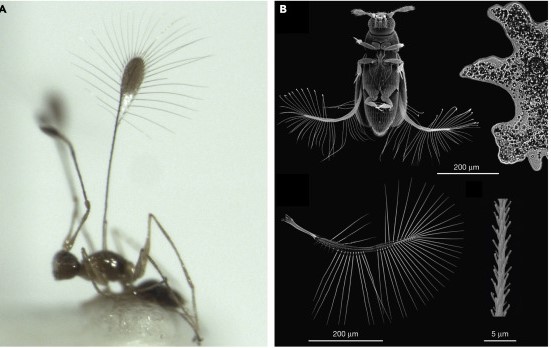
The finesse of sub-millimeter insect flight with comb-like bristled wings raises intriguing questions, not only on fluid-structure interactions (FSI) but also on the mechanical behavior of the underlying, highly porous structures. Farisenkov et al. characterized the morphology and kinematics of one of the smallest flying insects, the featherwing beetle Paratuposa placentis. Their simulations of this beetle in flight quantified crucial aspects of its aerodynamics, explaining why porous bristled wings enable flight and how they produce unexpected speeds and accelerations.
Publications:
• Y. L. Lin, and P. M. Reis, “Not gone with the wind: active microscale flight with highly porous bristled wings”, Matter, 5, 2550-2552 (2022).[html, pdf]
Tapered foils favor traveling-wave kinematics to enhance the performance of flapping propulsion
with: P. Leroy-Calatayud, M. Pezzulla, A. Keiser, and K. Mulleners
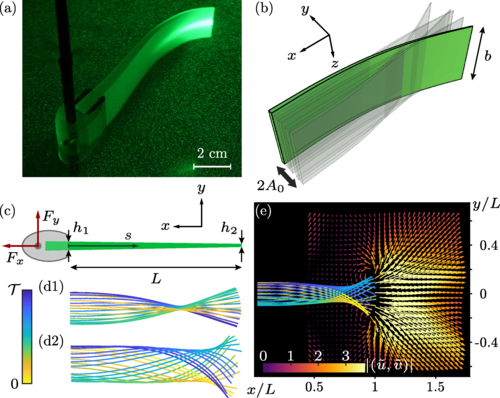
We report results from an experimental investigation on the fluid-structure interactions of flapping foils with tapered thickness profiles actuated in a quiescent viscous fluid. We seek to assess the propulsive performance of two sets of flapping foils; one with a fixed average bending stiffness, the other one with a fixed mass ratio. We find that foils that are stiffer towards the root than at their tip produce higher values of thrust and efficiency simultaneously, over a wide range of driving frequencies. Our kinematic analysis reveals that more tapered foils naturally develop a traveling-wave-dominated motion. We perform particle image velocimetry to relate the dynamics and kinematics of the flapping foils to the dynamics of the surrounding fluid. For more tapered foils, we observe a stronger vorticity production and a wake pattern with enhanced downstream speed of the fluid. Our paper provides experimental evidence that tapered stiffness distributions robustly enhances propulsive performance.
Publications:
• P. Leroy-Calatayud, M. Pezzulla, A. Keiser, K. Mulleners, and P. M. Reis, “Tapered foils favor traveling-wave kinematics to enhance the performance of flapping propulsion”, Physical Review Fluids, 7, 074403 (2022). [html, pdf]
Flexural-tensegrity snapping tails for bio-inspired propulsion in fluids
with: C. Boni, and G. Royer-Carfagni
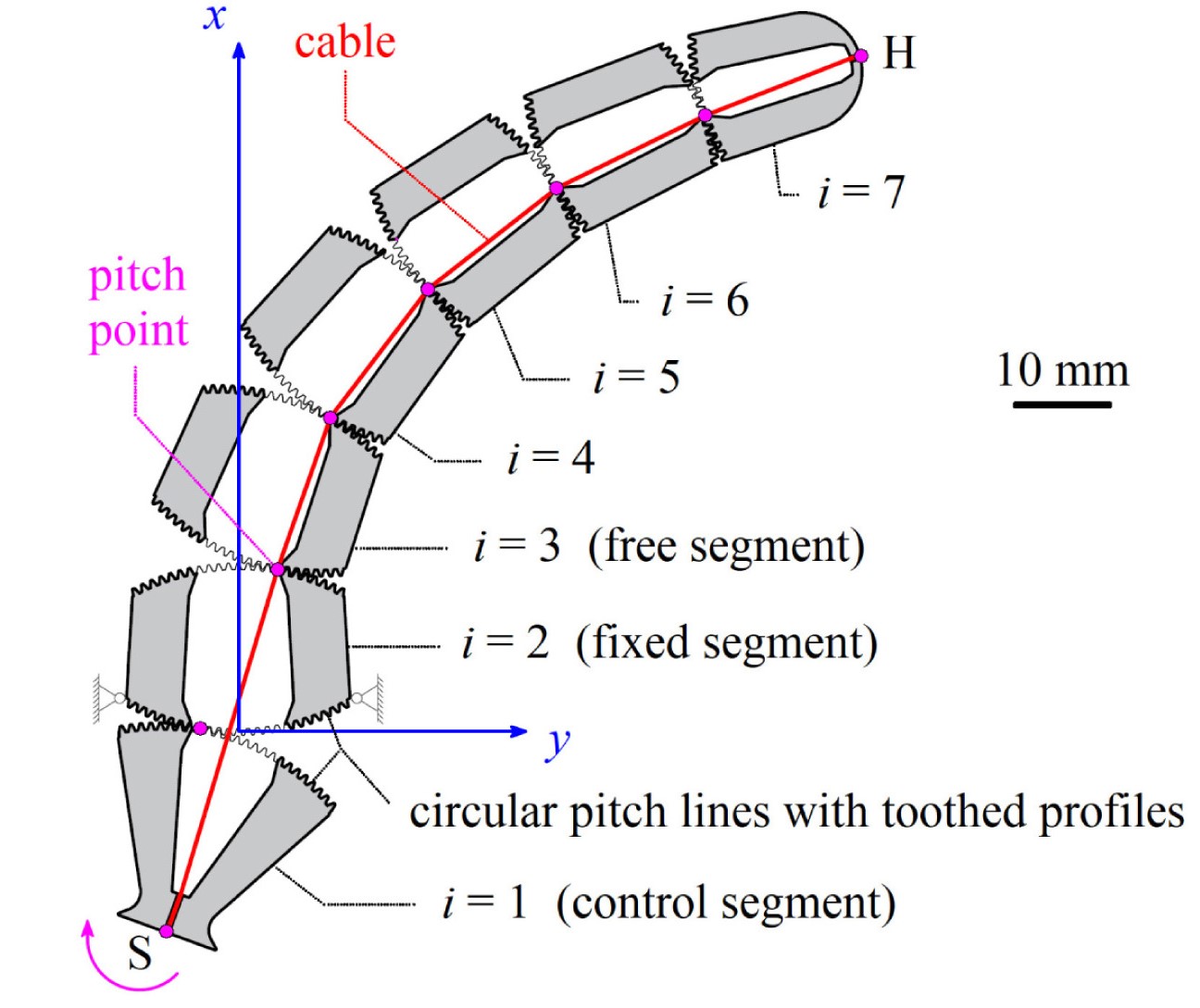
Many aquatic animals propel themselves by flapping their tails. Leveraging a recently proposed snapping cantilever beam based on the concept of flexural tensegrity, we propose a bio-inspired propulsion device. The design comprises a segmental beam with hollow voussoirs in unilateral contact along tailor-shaped surfaces, held together by a prestressed internal cable. Prescribing relative periodic rotation to a pair of consecutive control segments of the structured beam produces multi-articulated sequential snapping of all joints. We built a series of prototypes and performed precision experimental tests in water to characterize their propulsive capacity. A parametric study was carried out to characterize the dependence of the thrust produced by the oscillating tail on the following factors: number of segments, shape of the internal cavities dictating the cantilever curvature, and mobility constraint of a fin appended at the end of the tail. The results provide a proof of concept that our design for a snapping structured beam can be used as a propulsive device. We further demonstrate the feasibility of this propulsion unit to propel a toy boat in a water basin.
Publications:
• C. Boni, P.M. Reis, and G. Royer-Carfagni. ”Flexural-tensegrity snapping tails for bio-inspired propulsion in fluids”, Extreme Mechanics Letters, 56, 101853 (2022). [html, pdf]
Deformation of porous flexible strip in low and moderate Reynolds number flows
with: M. Pezzulla, E. F. Strong, and F. Gallaire
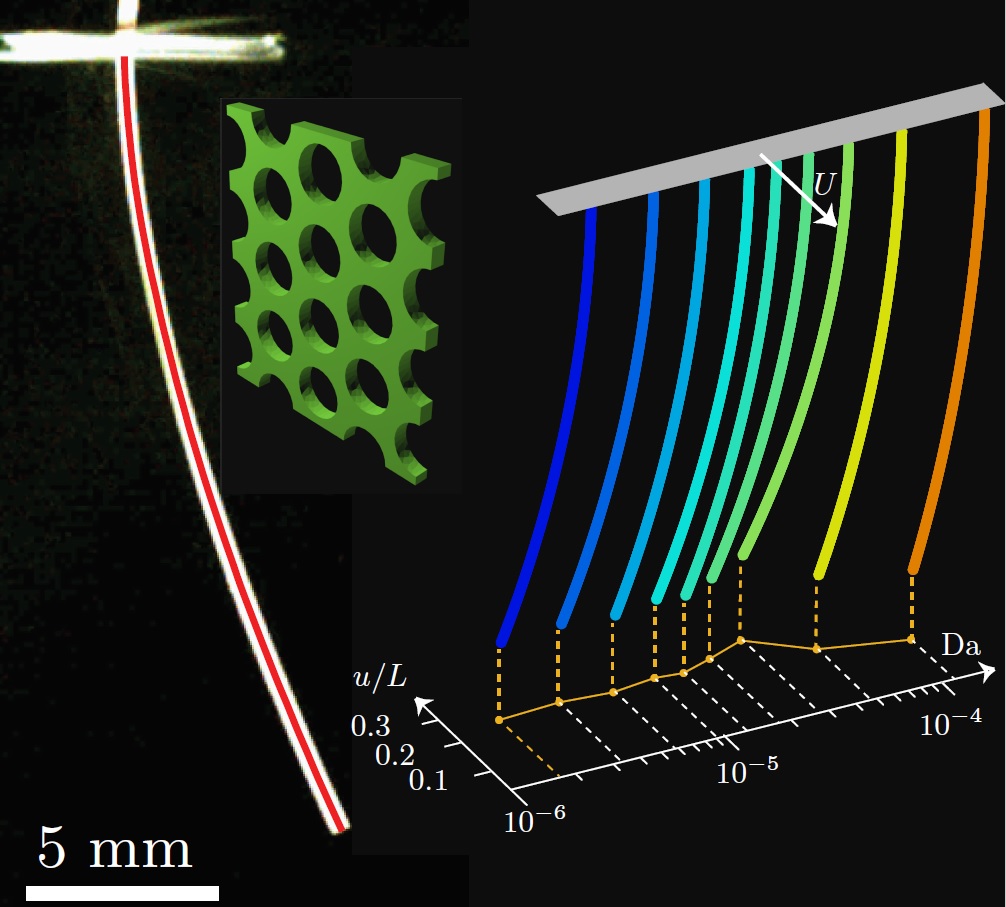
We present results from a combined experimental and numerical investigation of the fluid-structure interaction of cantilevered porous flexible strips, towed through a fluid bath. We characterize the steady-state deformation of the strips and their associated drag, focusing on the low and moderate Reynolds (Re) number regimes. Our microfabricated strips offer independent control over porosity and permeability, a feature not available in previous studies. We fabricate strips with different levels of permeability, spanning over two orders of magnitude, while fixing their porosity at 50%. Then, the vertically clamped porous strips are towed inside a viscous bath. In parallel to the experiments, we model the strip as an elastica that is loaded locally by low (or moderate) Reynolds forces, via local drag coefficients. At low Re, we find that the drag coefficient, which can be obtained from Stokes simulations of rigid strips under perpendicular flow, varies with permeability by less than 10%. By contrast, at moderate Re, the drag coefficient depends significantly and nonmonotonically on permeability. Whereas porosity dictates the drag coefficient at low Re, our results demonstrate that a precisely designed permeability plays a major role at moderate Re, enabling large variations of the drag coefficients at a set level of porosity. Since porosity is directly linked to weight via the density of the effective solid, understanding how porous structures of fixed porosity and varying permeability interact with the surrounding fluid is of relevance to flying insects and microdrones.
Publications:
• M. Pezzulla, E. F. Strong, F. Gallaire, and P. M. Reis, “Deformation of porous flexible strip in low and moderate Reynolds number flows” Phys. Rev. Fluids, 5, 084103 (2020). [html, pdf]
Hydrodynamic loading of perforated disks in creeping flows
with: E. F. Strong, M. Pezzulla, F. Gallaire, and L. Siconolfi
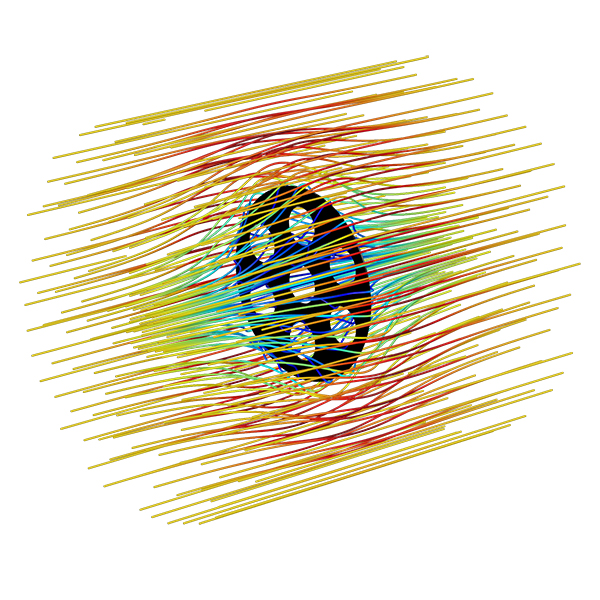
We present results from an experimental investigation of a viscous fluid driven through and around porous disks at low and moderate Reynolds number conditions. Specifically, we quantify the hydrodynamic drag that thin circular disks exhibit as a function of their size and the shape of their voids, while keeping their porosity fixed. We characterize the hydrodynamic loading using the drag ratio, which compares the magnitudes of drag experienced by a porous disk versus that of an impermeable, but otherwise equivalent, reference disk. We find that this drag ratio depends on the effective void radius, but not on the thickness of the disk. During this analysis, great attention has been dedicated to properly account for the effect of the wall confinement on the experimental data. Through scaling analysis, we rationalize our results by comparing them to an existing analytical solution for flow through and around porous disks. In particular, we find that an existing model based on Darcy flow within the porous disk and on Stokes flow outside the disk can be used in conjunction with a permeability model based on aperture flow to predict the forces that porous disks experience, even though the disks have finite thickness. Ultimately, we are able to combine these existing models to successfully predict the dependence of our experimentally measured drag ratio as a function of the Brinkman parameter of the perforated disks, at a fixed level of porosity. In contrast to the sedimentation experiments that are typically employed to evaluate the geometrical effects on the drag forces experienced by objects at low Re, our experiments were displacement controlled.
Publications:
• E. F. Strong, M. Pezzulla, F. Gallaire, P. M. Reis, and L. Siconolfi, “Hydrodynamic loading of perforated disks in creeping flows” Phys. Rev. Fluids, 4, 084101 (2019). [html, pdf]
| Programmable aerodynamic drag on morphable cylinders
with: M. Guttag and D. Yan |
|
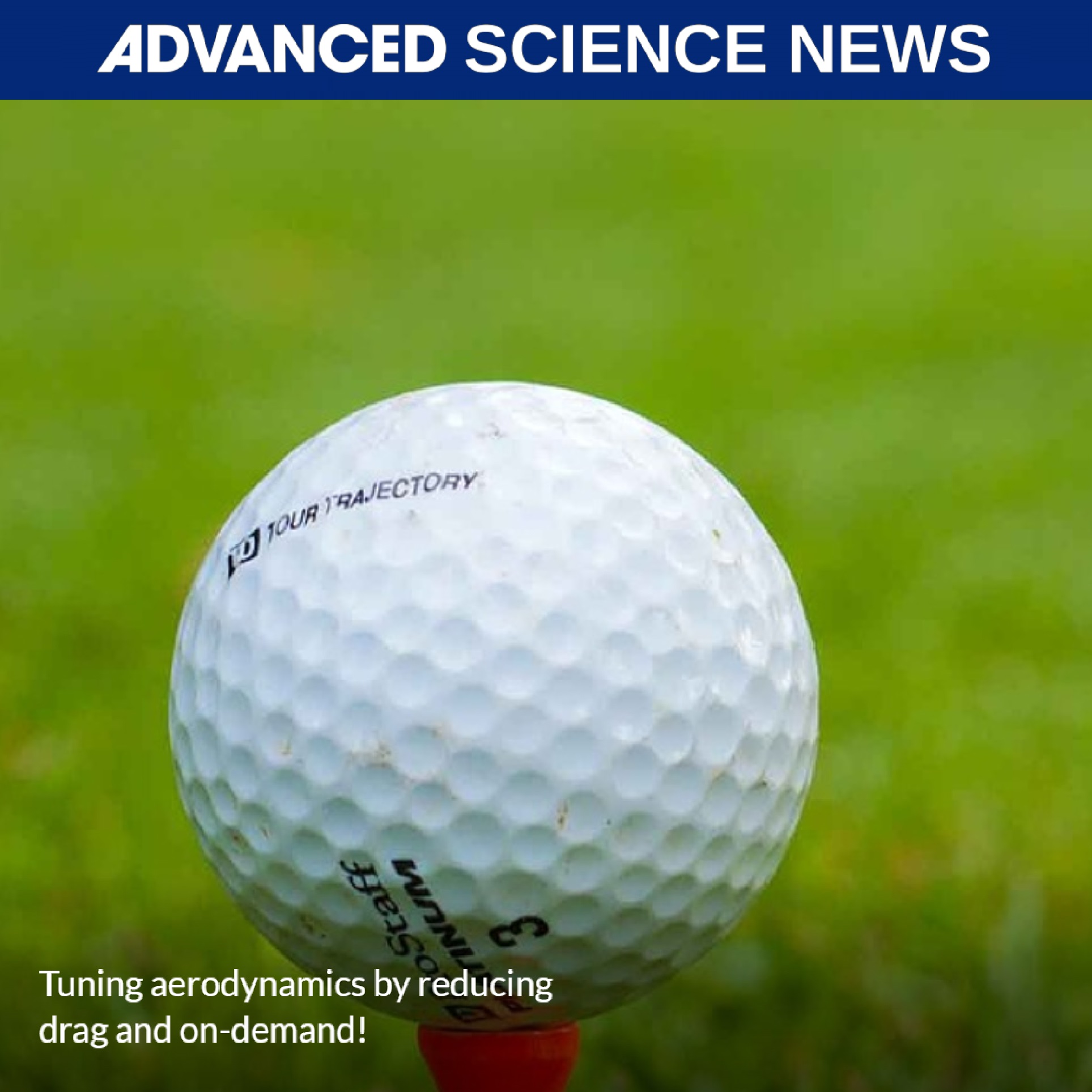
|
This study demonstrates that the aerodynamic drag profile of a patterned deformable cylinder at high Reynolds numbers can be programmed, on demand, by modifying its topography through pneumatic actuation. The samples used in the experiments comprise a rigid tube containing a hexagonal array of holes, over which an elastomeric cylindrical membrane is stretched. Decreasing the internal pressure of the structure causes an inward deflection of the outer membrane over the holes, thereby producing a regular pattern of dimples. The depth of these dimples can be controlled by tuning the pressure differential. The relationship between the mechanical deformation of the membrane and the pneumatic loading is characterized using a combination of finite element simulations and precision mechanical experiments. Wind tunnel experiments are performed to study how both the depth and the diameter of the dimples dictate the aerodynamic performance of the samples in the critical Reynolds number regime. Finally, the tunable nature of the specimens is exploited to automatically control the dependence of the drag coefficient on the Reynolds number, toward targeting predefined drag profiles. Publications: Press Coverage: |
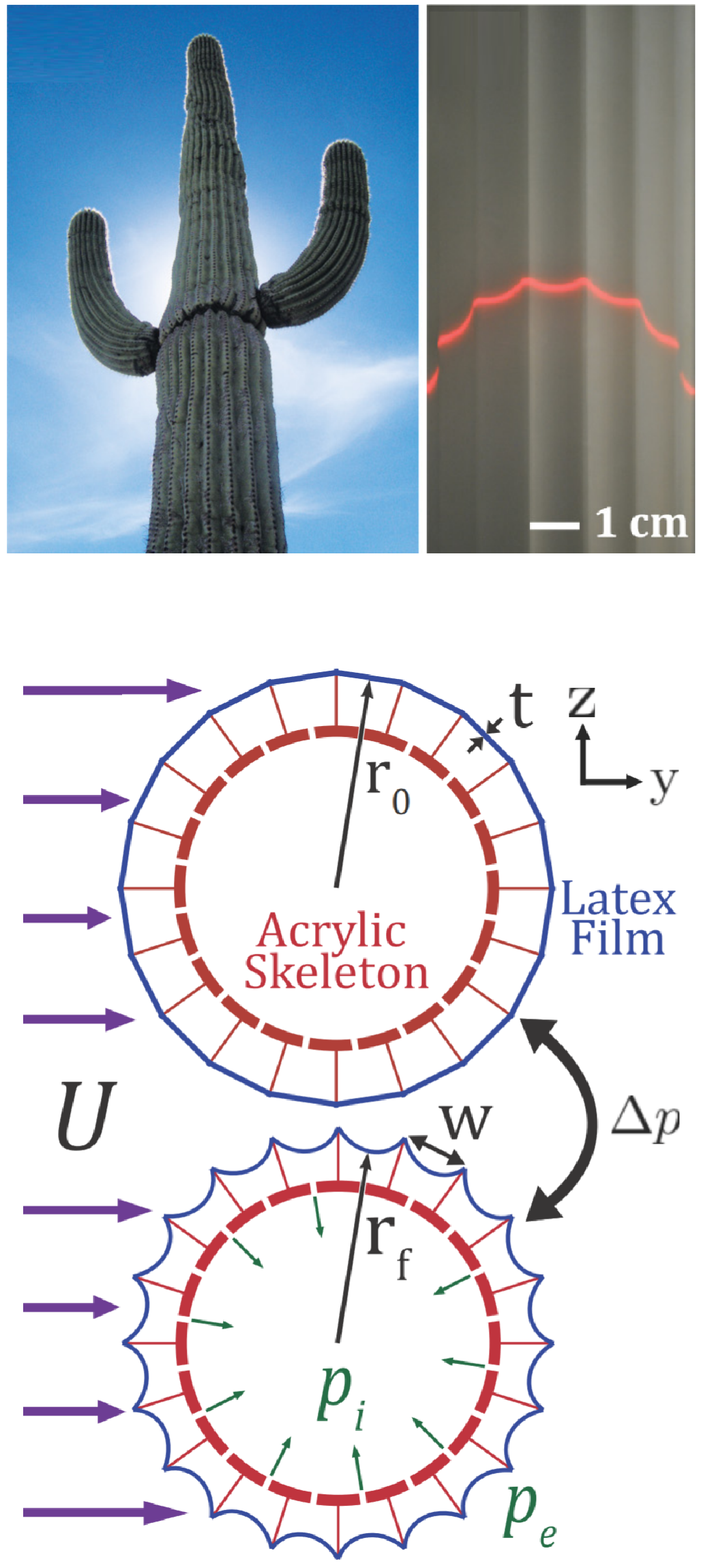
|
We study a mechanism for active aerodynamic drag reduction on morphable grooved cylinders, whose topography can be modified pneumatically. Our design is inspired by the morphology of the Saguaro cactus (Carnegiea gigantea), which possesses an array of axial grooves, thought to help reduce aerodynamic drag, thereby enhancing the structural robustness of the plant under wind loading. Our analog experimental samples comprise a spoked rigid skeleton with axial cavities, covered by a stretched elastomeric film. Decreasing the inner pressure of the sample produces axial grooves, whose depth can be accurately varied, on demand. First, we characterize the relation between groove depth and pneumatic loading through a combination of precision mechanical experiments and finite element simulations. Second, wind tunnel tests are used to measure the aerodynamic drag coefficient (as a function of Reynolds number) of the grooved samples, with different levels of periodicity and groove depths. We focus specifically on the drag crisis and systematically measure the associated minimum drag coefficient and the critical Reynolds number at which it occurs. The results are in agreement with the classic literature of rough cylinders, albeit with an unprecedented level of precision and resolution in varying topography using a single sample. Finally, we leverage the morphable nature of our system to dynamically reduce drag for varying aerodynamic loading conditions. We demonstrate that actively controlling the groove depth yields a drag coefficient that decreases monotonically with Reynolds number and is significantly lower than the fixed sample counterparts. These findings open the possibility for the drag reduction of grooved cylinders to be operated over a wide range of flow conditions. Publications: |
| Designing soft materials with interfacial instabilities in liquid films
with: J. Marthelot, E. F. Strong, and P.-T. Brun |
|
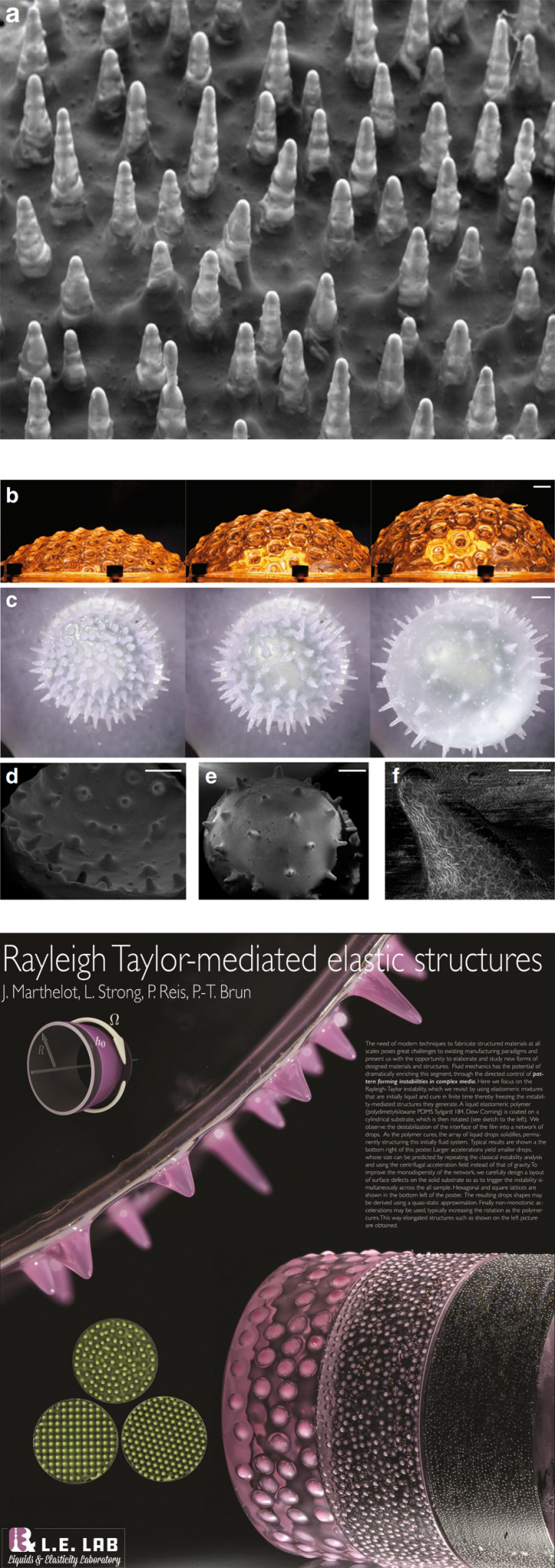
|
Natural soft materials harness hierarchy and structures at all scales to build function. Adapting this paradigm to our technological needs, from mechanical, phononic and photonic metamaterials to functional surfaces prompts the development of new fabrication pathways with improved scalability, design flexibility and robustness. Here we show that the inherent periodicity of the Rayleigh–Taylor instability in thin polymeric liquid films can be harnessed to spontaneously fabricate structured materials. The fluidic instability yields pendant drops lattices, which become solid upon curing of the polymer, thereby permanently sculpting the interface of the material. We solve the inverse design problem, taming the instability, so that the structures we form can be tailored, over a range of sizes spanning over two decades. This all-in-one methodology could potentially be extended down to the scales where continuum mechanics breaks down, while remaining scalable. Publications: • J. Marthelot, E. F. Strong, P. M. Reis, and P.-T. Brun, “Solid structures generated by capillary instability in thin liquid films” Phys. Rev. Fluids, 3, 100506 (2018). [html, pdf, poster] |
| Aeroelastic deformation of a perforated strip
with: M. Guttag, H. H. Karimi, and C. Falcónel |
|
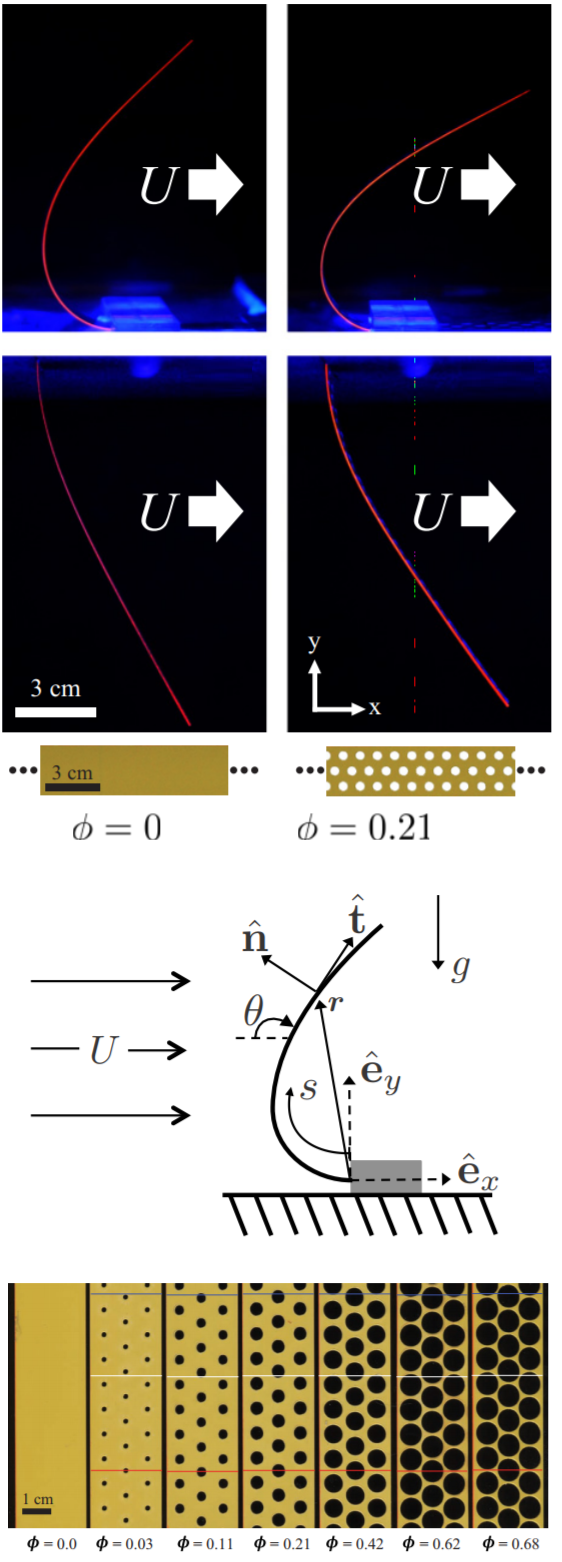
|
We perform a combined experimental and numerical investigation into the static deformation of perforated elastic strips under uniform aerodynamic loading at high-Reynolds-number conditions. The static shape of the porous strips, clamped either horizontally or vertically, is quantified as they are deformed by wind loading, induced by a horizontal flow. The experimental profiles are compared to numerical simulations using a reduced model that takes into account the normal drag force on the deformed surface. For both configurations (vertical and horizontal clamping), we compute the drag coefficient of the strip, by fitting the experimental data to the model, and find that it decreases as a function of porosity. Surprisingly, we find that, for every value of porosity, the drag coefficients for the horizontal configuration are larger than those of the vertical configuration. For all data in both configurations, with the exception of the continuous strip clamped vertically, a linear relation is found between the porosity and drag. Making use of this linearity, we can rescale the drag coefficient in a way that it becomes constant as a function of the Cauchy number, which relates the force due to fluid loading on the elastic strip to its bending rigidity, independently of the material properties and porosity of the strip and the flow speed. Our findings on flexible strips are contrasted to previous work on rigid perforated plates. These results highlight some open questions regarding the usage of reduced models to describe the deformation of flexible structures subjected to aerodynamic loading. Publications: |
| Wrinkling on curved surfaces & Smorphs: smart morphable surface for aerodynamic drag reduction with: Denis Terwagne, Miha Brojan, Romain Lagrange, Norbert Stoop, Jorn Dunkel |
|
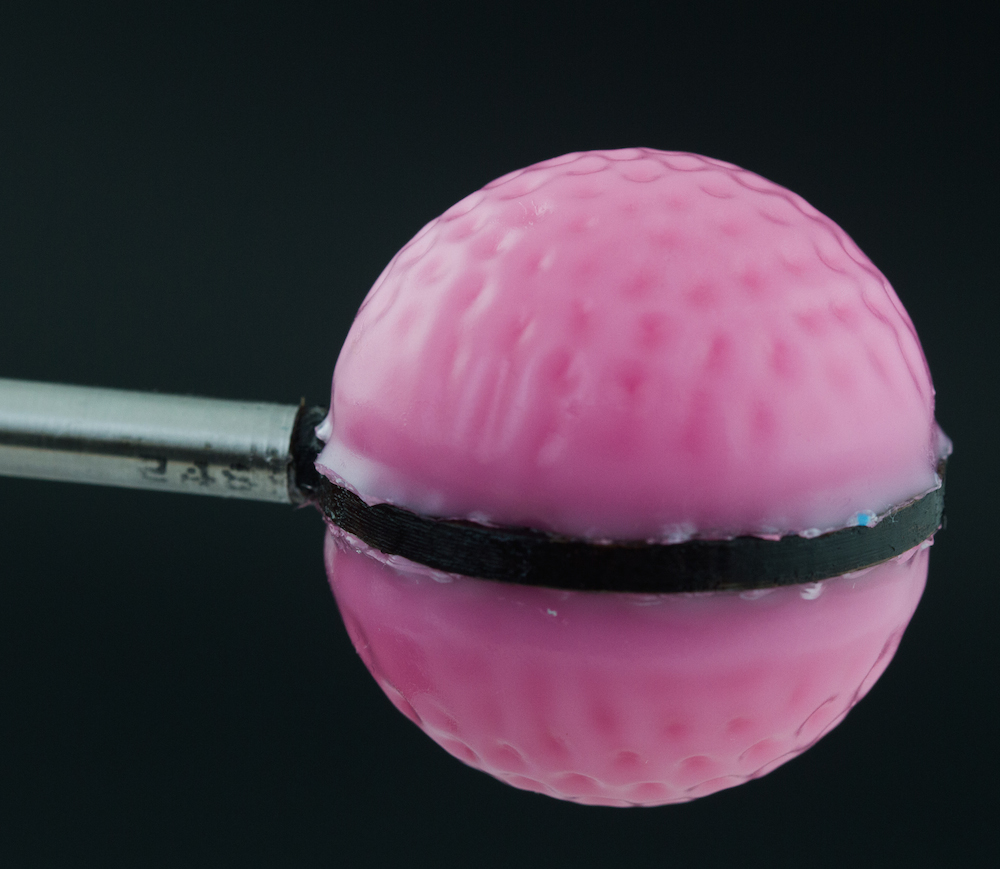
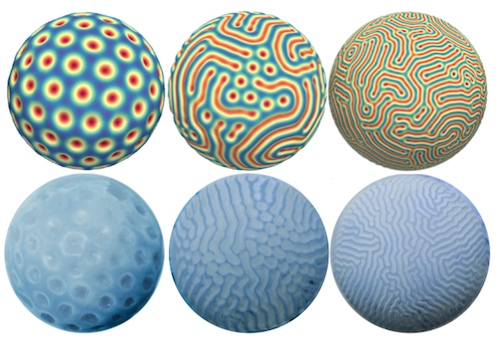
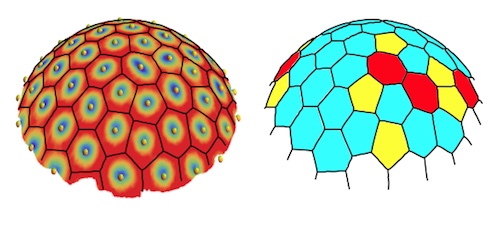
|
We have devised a new class of Smart Morphable Surfaces, which we refer to as Smorphs, that make use of a wrinkling instability on curved surfaces to generate custom, switchable and tunable topography. Our experiments show that surface curvature qualitatively affects the wrinkled pattern, when compared to flat film-substrate systems. Inspired by the resemblance of our dimpled patterns and those of golf balls, we have characterized their aerodynamic performance and found that the drag coefficient can be reduced, on demand, by up to a factor of two. A particularly novel aspect of our Smorphs is that complex topography can be rapidly activated with a single pressure signal and their actuation speed is only limited by how fast the depressurization can be set. The fast elastic response of our mechanism opens the possibility of on demand and dynamic drag control. We envision that our Smorphs could find applications in a variety of aerodynamic structures. Strategically reducing the overall drag on the outer-body shell of automobiles or aircraft could potentially lead to enhanced fuel efficiency; a timely priority for these industries. A video of one of our Smorphs in action can be found here: [Movie] Publications: Press Coverage: |
| How Cats Lap: Water uptake by Felis catus
with: Sunny Jung, Jeff Aristoff and Roman Stocker |
|
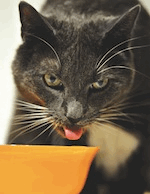
|
Have you ever wondered how a cat drinks? Various animals have developed a range of drinking strategies depending on physiological and environmental constraints. Vertebrates with incomplete cheeks use their tongue to drink; the most common example is the lapping of cats and dogs. We have shown that the domestic cat (Felis catus) laps by a subtle mechanism based on water adhesion to the dorsal side of the tongue. A combined experimental and theoretical analysis reveals that Felis catus exploits fluid inertia to defeat gravity and pull liquid into the mouth. This competition between inertia and gravity sets the lapping frequency and yields a prediction for the dependence of frequency on animal mass. Measurements of lapping frequency across the family Felidae support this prediction, which suggests that the lapping mechanism is conserved among felines. How does a cat drink? (slowed down 12x) [Movie] |
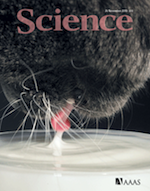
|
Publications: Press Coverage: |
| Grabbing Water
with: Jérémy Hure, Sunny Jung, John Bush and Christophe Clanet |
|
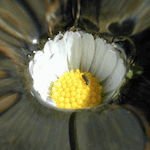
|
We introduce a novel technique for grabbing water with a flexible solid. This new passive pipetting mechanism was inspired by floating flowers and relies purely on the coupling of the elasticity of thin plates and the hydrodynamic forces at the liquid interface. Developing a theoretical model has enabled us to design petal-shaped objects with maximum grabbing capacity. How to grab a bubble of air? [Movie]
Press Coverage: |
| The Clapping Book
with: Peter Buchack, Christophe Eloy |
|

|
We present a hybrid experimental and theoretical study on the oscillatory behavior exhibited by multiple thin sheets under aerodynamic loading. Our clapping book consists of a stack of paper, clamped at the downstream end, placed in a wind tunnel with steady flow. As pages lift off, they accumulate onto a bent stack held up by the wind. The book collapses shut once the elasticity and weight of the pages overcome the aerodynamic force; this process repeats periodically. We develop a theoretical model that predictively describes this periodic clapping process. A movie of this Clapping process can be found [here].
Press Coverage: |
